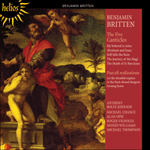Canticle V,
The Death of Saint Narcissus, Op 89, was written in 1974 while Britten was recuperating from a heart operation. His wide reading at this time included poetry by T S Eliot, whom he admired ‘for the clarity and security of his language’, and he decided to set this early poem in memory of his friend William Plomer, author of the words of
Gloriana and the three Church Parables, who had died the previous year. As Britten was still not well enough to play the piano himself, the accompaniment was assigned to the harp, to be played by his friend and colleague Osian Ellis, the vocal line being given to the tenor voice. Britten himself was to die the following year, and this setting is an instance of his apparent preoccupation with death in his final years, of which the most notable example was his last opera,
Death in Venice.
from notes by Michael Short © 1992
Britten écrivit le cinquième Cantique,
The Death of Saint Narcissus en 1974, alors qu’il se remettait d’une opération cardiaque. Parmi ses nombreuses lectures à l’époque figurait la poésie de T S Eliot, qu’il admirait «pour la clarté et la solidité de son langage», et il décida de mettre en musique ce poème de jeunesse en mémoire de son ami William Plomer, auteur du texte de
Gloriana et des trois Paraboles liturgiques, qui était mort l’année précédente. Britten n’étant pas encore assez remis pour jouer lui-même du piano, l’accompagnement fut confié à la harpe de son ami et collègue Osian Ellis, tandis que la ligne vocale était attribuée à la voix ténor. Britten lui-même allait mourir l’année suivante, et cet arrangement témoigne de son apparente préoccupation de la mort pendant ses dernières années, dont la manifestation la plus notable est son dernier opéra,
Death in Venice.
extrait des notes rédigées par Michael Short © 1992
Français: Elisabeth Rhodes
Das V. Canticle
The Death of Saint Narcissus, entstand 1974, während sich Britten von einer Herzoperation erholte. Zu seiner umfassenden Lektüre gehörten damals Gedichte von T S Eliot, den er „wegen der Klarheit und Sicherheit seiner Sprache“ bewunderte. Britten beschloß, das vorliegende frühe Gedicht zu vertonen, und zwar zum Andenken an seinen Freund William Plomer, den Textdichter der Oper
Gloriana und der drei Kirchenparabeln, der im Vorjahr gestorben war. Da es Britten noch nicht gut genug ging, um selbst Klavier zu spielen, wurde die Begleitung der Harfe zugewiesen, zu spielen von seinem Freund und Kollegen Osian Ellis, und der Gesangspart wurde der Tenorstimme übertragen. Britten sollte im Jahr darauf sterben, und diese Vertonung ist ein Beispiel dafür, wie sehr ihn in seinen letzten Lebensjahren der Gedanke an den Tod beschäftigte. Das bekannteste Beispiel hierfür ist seine letzte Oper
Death in Venice.
aus dem Begleittext von Michael Short © 1992
Deutsch: Anne Steeb/Bernd Müller



 Britten: The Five Canticles
Britten: The Five Canticles
